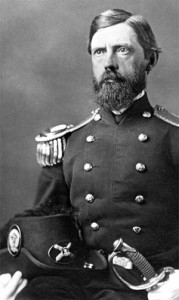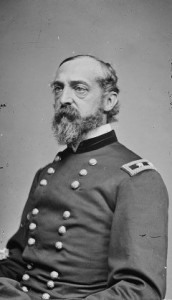Meade Takes Command
Joe Hooker had been slow to move the army north. That much was irritating. But when he demanded to be reinforced with troops from the Harper’s Ferry garrison, that was quite enough. When the request was refused by General Halleck, Hooker sent back a message threatening to quit if he didn’t get his way. Lincoln and Halleck were only too happy to accept the resignation.

Of course, this created a new problem: who should replace him? The most capable General in the Army of the Potomac – and the one Lincoln had the most confidence in – was Major General John Reynolds, commander of the I Corps. The job was offered to him.
Reynolds was no dummy, though. He had seen what happened to the previous army commanders: one misstep and your career was finished. This would be the 7th commanding General in the eastern theatre in just over 2 years. For Reynolds, the answer was thanks, but no thanks.
His second choice was a much different man, a quieter man: George G. Meade. At about 3:00am, 150 years ago today, Major General Meade was awakened at his camp in Frederick, MD by a messenger from Washington, DC. He had no idea what was going on. His first thought was that he was being arrested for some reason. Alas, he was told that he had been promoted – and that he didn’t have a choice in the matter. Out of a sense of duty, he accepted the charge.

The situation was grim. Meade knew where his own troops were, but Hooker had kept all his subordinates in the dark about the over-all plan. The positions of the rest of the army’s corps was completely unknown to him. There was a lot of catching up to do.
Meade started thinking about his options. The orders from Washington (roughly the same ones Hooker had, though Meade was given a little more freedom) were twofold: 1) Destroy the Army of Northern Virginia; and 2) Protect Washington and Baltimore. The first required aggression, the second a conservative nature. This contradiction in orders would cause political problems for Meade when the campaign was dissected in hindsight. For now though, he continued the move north with the aggressive and capable General Reynolds in charge of the westernmost sector – the area where the rebels were most likely (and actually turned out) to be.
At the same time, he developed a defensive position – the Pipe Creek Line – that he was hoping to draw Lee into once the fighting began. Acting defensively on ground that he had scouted out and fortified was the best way Meade could see to achieve both of his objectives.
He wouldn’t have to wait long to see how it was going to play out. In just 3 days, Meade would face the biggest test of his career.
2 thoughts on “Meade Takes Command”